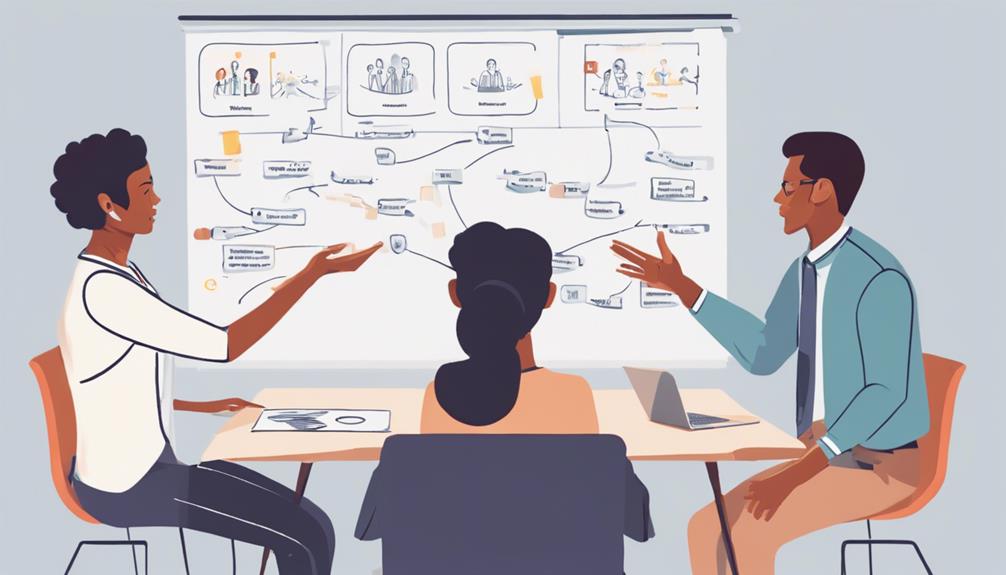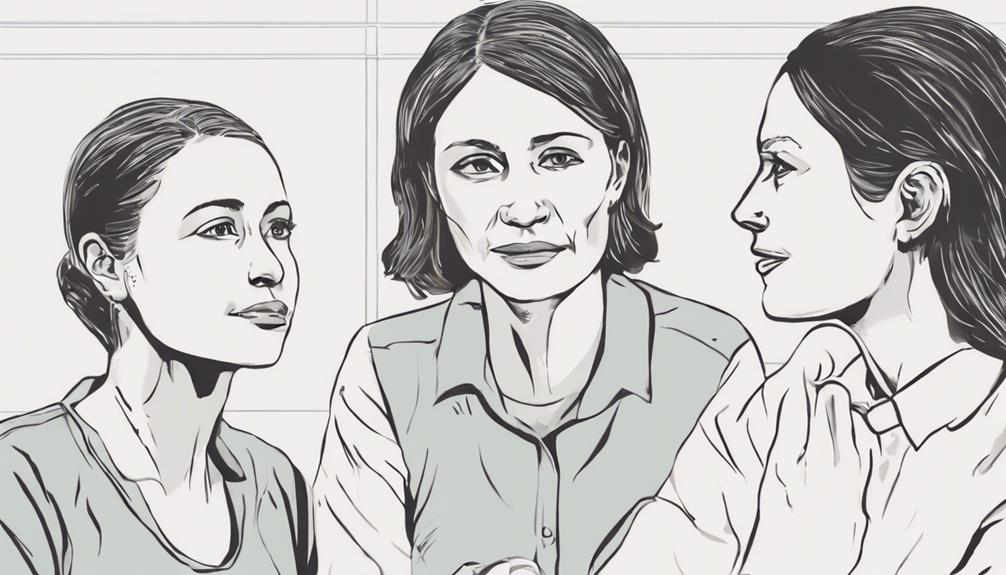Enhance your transformation training with crucial communication tips. Clear goals set expectations and foster accountability. Respect others with a positive tone for a safe, open environment. Listen actively, watch for cues, and reflect understanding. Give feedback balancing criticism and positivity. Show empathy, validate feelings, and encourage dialogue. Build trust through honesty, inclusivity, and confidentiality. Remember to seek consent, maintain privacy, and handle information sensitively. Communicate data usage clearly and prioritize confidentiality. Master these tips to elevate engagement and create an empathetic learning atmosphere that supports growth and understanding.
Establish Clear Expectations

To kick off your transformation training successfully, ensure you clearly outline the expectations for all participants. Setting clear goals from the start will provide a roadmap for everyone involved. Encourage participants to be accountable for their progress by regularly checking in on their individual objectives. Transparency is key in transformation training. Be open about the program's purpose, what's expected from each participant, and how progress will be measured.
Consistency is crucial for maintaining momentum throughout the training. Make sure that expectations are consistently communicated to all participants. Regular reminders and updates can help reinforce the goals and keep everyone on track. Consistent feedback and support will also be essential in helping participants stay motivated and focused on their objectives.
Use Respectful Language
Maintain a respectful tone and demeanor when communicating with participants in transformation training to foster a positive and collaborative learning environment. Respectful communication is essential in creating a safe space where individuals feel valued and motivated to engage in the training process.
Using positive reinforcement can further enhance this atmosphere by acknowledging the efforts and progress of participants. When providing feedback or guidance, remember to frame your words in a way that uplifts and encourages. Instead of using harsh or negative language, opt for constructive criticism that focuses on growth and improvement.
For example, instead of saying, 'You're doing that wrong,' you could say, 'Great effort! Let's try approaching it this way for even better results.'
Active Listening Techniques

Using active listening techniques is essential for effective communication in transformation training sessions. Reflective listening plays a crucial role in ensuring that you understand the speaker's message accurately. When practicing reflective listening, try paraphrasing what the speaker said to demonstrate your understanding. This shows respect and helps clarify any potential misunderstandings.
Additionally, pay attention to nonverbal cues such as facial expressions, body language, and tone of voice. These cues provide valuable insights into the speaker's emotions and can guide your responses accordingly.
To enhance your active listening skills further, maintain eye contact to show your attentiveness and interest. Nodding occasionally and using verbal affirmations like 'I see' or 'I understand' can also encourage the speaker to open up and share more.
Provide Constructive Feedback
Enhancing your communication skills in transformation training involves providing constructive feedback that fosters growth and development in both yourself and others. Feedback techniques play a crucial role in facilitating learning and improvement.
When giving feedback, remember to balance constructive criticism with positive reinforcement. This helps create a supportive environment where individuals feel motivated to make positive changes.
Communication styles greatly impact how feedback is received. When offering constructive criticism, it's essential to be clear, specific, and empathetic. Constructive feedback should focus on behaviors or actions rather than personal traits to ensure that it's well-received and leads to productive outcomes.
Additionally, active listening during feedback sessions demonstrates respect and understanding, encouraging open dialogue and collaboration.
Practice Empathy and Understanding

To truly connect and support others in their growth journey, practicing empathy and understanding is essential in communication during transformation training.
Empathy exercises and understanding activities can aid in fostering a supportive environment where individuals feel heard and valued. Start by actively listening to others without judgment, allowing them to express their thoughts and feelings openly. Put yourself in their shoes to comprehend their perspective better. Validate their emotions by acknowledging their experiences and showing compassion towards their challenges.
Engage in role-playing scenarios to practice responding with empathy in different situations that may arise during transformation training. This can help you understand varying viewpoints and respond appropriately with empathy and understanding.
Encourage open discussions where individuals feel comfortable sharing their concerns and insights, creating a space for mutual respect and empathy to flourish. By consistently practicing empathy and understanding in your communication, you can cultivate a positive and supportive atmosphere that enhances the transformation journey for all participants.
Encourage Open Dialogue
Encourage participants to share their thoughts and feelings openly to foster a culture of open dialogue during transformation training. Honest conversations are the cornerstone of effective communication. By creating an environment where vulnerability in discussions is embraced, individuals can express themselves authentically.
Transparent communication plays a vital role in building trust among participants, allowing for meaningful connections to form.
When encouraging open dialogue, remind participants that their perspectives are valued and respected. Encourage them to voice their opinions, ask questions, and engage in active listening. This practice not only enhances understanding but also promotes a sense of inclusivity within the group.
Emphasize the importance of honesty in exchanges, as it paves the way for genuine interactions and deeper connections.
Set Boundaries and Limits

Establish clear boundaries and limits to ensure a structured and respectful environment throughout the transformation training process. Personal boundaries are crucial in maintaining a healthy dynamic between trainers and trainees. It's essential to communicate what's acceptable and unacceptable in terms of behavior, language, and interaction.
Encouraging participants to respect each other's personal boundaries fosters a sense of safety and trust within the training space. Additionally, setting professional limits is equally important. Clearly outline the scope of the training, what topics will be covered, and what issues are beyond the training's purview.
This helps manage expectations and prevents any misunderstandings during the program. Emphasize the importance of maintaining a professional demeanor and refraining from crossing professional boundaries.
Foster a Safe Environment
Creating a safe environment is foundational for effective communication and growth during transformation training. Trust building is crucial in fostering this safe space where individuals feel comfortable expressing themselves openly. Encourage participants to share their thoughts, feelings, and experiences without fear of judgment. By actively listening and validating their emotions, you can establish a foundation of trust that encourages vulnerability sharing.
To build trust, be genuine, empathetic, and responsive to the needs of each individual. Acknowledge their perspectives and show understanding towards their struggles. Creating a supportive atmosphere where everyone feels respected and valued will enhance communication and foster a sense of community within the training program.
Moreover, vulnerability sharing plays a significant role in personal growth and development. Encourage participants to open up about their challenges, fears, and aspirations. By creating a non-judgmental environment, individuals can feel empowered to be authentic and explore their emotions freely.
Maintain Confidentiality

To maintain confidentiality in transformation training, prioritize safeguarding the personal information shared by participants. Confidentiality is of utmost importance in building trust within the training environment. Participants must feel secure that what they share will be kept private, creating a safe space for open communication and growth.
Respecting confidentiality not only fosters trust but also shows participants that their privacy is valued. It allows individuals to express themselves without fear of judgment or breach of trust. By upholding confidentiality, you demonstrate integrity and professionalism, enhancing the overall training experience.
Seek Consent and Respect Privacy
Ensure that before gathering any personal information, you seek explicit consent and respect the privacy of participants in transformation training. Establishing clear consent boundaries is essential to creating a safe and trusting environment for everyone involved.
Always communicate the purpose of collecting any personal data and ensure that participants understand how their information will be used and stored.
Respecting privacy is crucial in transformation training to uphold the confidentiality and trust of each individual. Safeguarding personal information and maintaining privacy standards demonstrate your commitment to creating a respectful and ethical training environment.
Remember that participants may have sensitive experiences or emotions they're sharing, and it's vital to handle this information with care and discretion.
Conclusion
In conclusion, follow these 10 tips for effective communication in transformation training.
By establishing clear expectations, using respectful language, and practicing active listening, you can create a safe and supportive environment for growth and learning.
Remember to provide constructive feedback, show empathy, and respect boundaries.
By fostering open communication, you can help individuals reach their full potential and achieve their goals in their transformation journey.
So, keep these tips in mind and communicate effectively for successful training outcomes.
